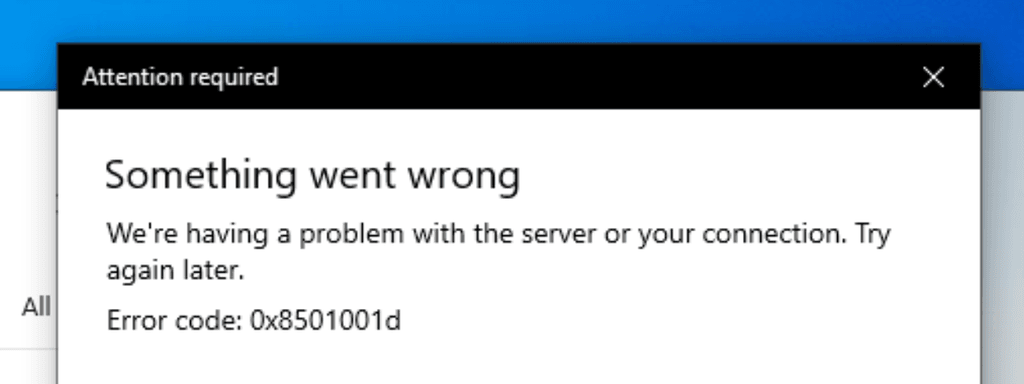ActiveSync
-
Why is it that Active sync is not supported by SOGo on cloudron?
https://docs.cloudron.io/apps/sogo/
ActiveSyncExchange ActiveSync is a protocol used by Microsoft Exchange to sync mobile devices. The Cloudron SOGo app does not support ActiveSync. It only supports clients that use IMAP/SMTP/CardDAV/CalDAV.
-
Why is it that Active sync is not supported by SOGo on cloudron?
https://docs.cloudron.io/apps/sogo/
ActiveSyncExchange ActiveSync is a protocol used by Microsoft Exchange to sync mobile devices. The Cloudron SOGo app does not support ActiveSync. It only supports clients that use IMAP/SMTP/CardDAV/CalDAV.
@privsec said in ActiveSync:
Why is it that Active sync is not supported by SOGo on cloudron?
This issue is tracked here. Also mentioned here and here.
-
We haven't spent much time trying to support this. TBH, one main issue is we lack all the devices (windows) and client combinations to test.
-
Hi,
@girish I re post here instead of the issue tracker, I think it's the good thread.Having activesync working in Sogo would be the last feature I need to completely migrate to Cloudron.
From what I read on the issue tracker the main problem is having the right version of libwbxml.
I've made some research on project that have working container with activesync and I found this one :
https://github.com/croessner/sogo/blob/master/Dockerfile
He fetched libwbxml sources then compile them before compiling Sogo ActiveSync.I'm not familiar with the base cloudron image, and missing some time to try myself, do you think someone of your staff can try this solution ?
Thanks to your team for the amazing work on Cloudron.
-
@nebulon sorry for the late reply.
To test ActiveSync you can try to connect with the Exchange connector available on all native mail client available on desktop (Windows/MacOS) and mobile OS (Android/iOS).
On the first configuration step the client always try to autoconfigure the server hostname but if it fail you can then enter your server hostname.The endpoint for activesync should be always on this path from what I understand /Microsoft-Server-ActiveSync
You have to not forget the reverse proxy configuration, an exemple is available on the readme of the repo.## !!! ActiveSync provided by Z-Push !!! ## #location ^~ /Microsoft-Server-ActiveSync { # access_log /var/log/nginx/activesync.log; # error_log /var/log/nginx/activesync-error.log; # # proxy_connect_timeout 75; # proxy_send_timeout 3600; # proxy_read_timeout 3600; # proxy_buffers 64 256k; # # proxy_set_header Host $host; # proxy_set_header X-Real-IP $remote_addr; # proxy_set_header X-Forwarded-For $proxy_add_x_forwarded_for; # proxy_pass http://127.0.0.1:20000/SOGo/Microsoft-Server-ActiveSync; # proxy_redirect http://127.0.0.1:20000/SOGo/Microsoft-Server-ActiveSync /; #}I'll be happy to help to test some image if you manage to compile activesync.
-
+1 to test if you add it. Plenty of business users around here are glued to their precious outlook application. (although with the coming big changes, maybe not for long).
-
+1 to test if you add it. Plenty of business users around here are glued to their precious outlook application. (although with the coming big changes, maybe not for long).
@AartJansen said in ActiveSync:
Plenty of business users around here are glued to their precious outlook application. (although with the coming big changes, maybe not for long).
Outlook is no fun with activesync however. It's ok if you have a small mailbox, but large mailboxes with frequent changes are problematic. If you want to use outlook (the old outlook will luckily be around for a few more years) and don't want to use Exchange/Microsoft 365, you need something like https://kopanion.de/
-
How do you define "big" mailbox ?
40Gb? I have a customer using outlook with imap. it seems a little slower than it did on exchange, to be fair, but its not "awful".
If active sync means calendar & contacts working without caldav sync plugin, and its somewhat manual set up, I'm all for it. -
I would already call a mailbox around 10gb big to be honest.
Navigating inside the mailbox is not necessarily the problem, in the end outlook saves the data in the same ost filetype locally (which btw has a file limit of 50gb). The problems come when:
- the user realises that a lot is not possible with an activesync mailbox (no native folder sharing, no out of office, not even able to move message between accounts in outlook since the activesync version used in outlook does not support to just "create" objects)
- you need to resync folders because they get out of sync
- microsoft breaks activesync with an update and takes its time to remedy the problem, most recent one was https://www.bleepingcomputer.com/news/microsoft/microsoft-outlook-clients-not-syncing-over-exchange-activesync/
- or if you open the same mailbox with multiple users at the same time
In the end Microsoft added activesync support to Outlook as an inbetween step to migrate users from hotmail.com to office 365 and never really intended it to be used in an office context.
-
50Gb is a soft limit you can change that with a simple registry edit. I have no doubt its set by default to that for a good reason though.
Out of office is clunky with non-exchange servers, resorting to webmail interface is usually the best option. Buts it's hardly a "must have feature", in my experience.
My end goal is to have a stable, low maintenance server, the mail client users have on the desktop is secondary to that. That said, I've tried multiple mail clients in an attempt to replace outlook, and they all have worse issues than outlook, even the ones with better features like ...
The BAT!
Thunderbird
emclient
Add to that sometimes people run their line of business app that integrates with MS office / outlook (ie sending invoices via email), and wont work with other mail clients at all. -
@vladimir-d worked on enabling active sync for SOGo however I am a bit at a loss how to test this even on windows. For some reason I all the outlook/mail/office365 clients I have tried from Microsoft only support adding exchange server via the Microsoft account.
Does anyone have a good guide on how to add a custom active sync server so we can test and fix the SOGo app?
-
Under windows 10 you can use the "Mail" app.
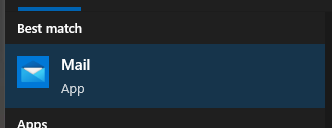
When you add an account you need to scroll down to the "Advanced setup"
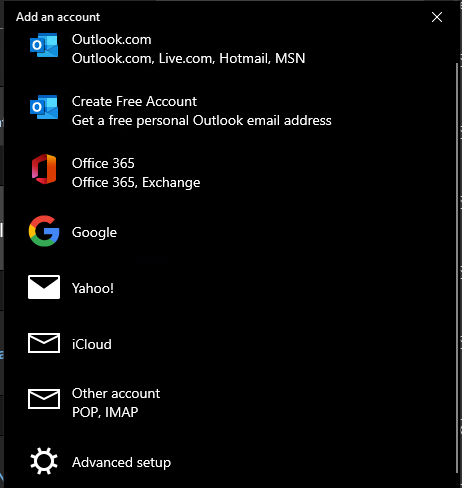
And then you can choose Exchange ActiveSync as the account type:
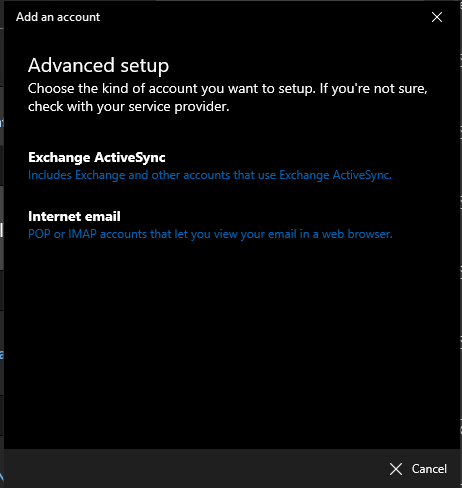
The data for the server should look something like this, you can leave the domain setting empty:
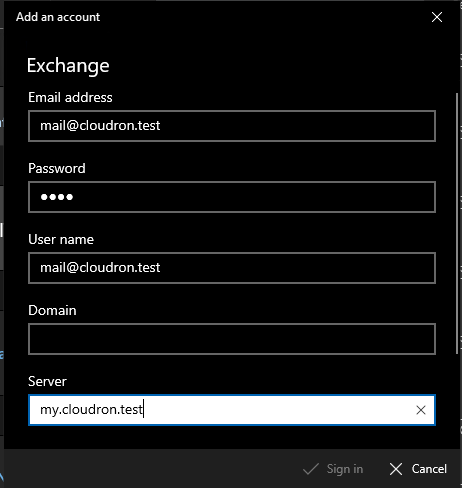
-
Can you use microsofts remote connectivity test site?
https://testconnectivity.microsoft.com/tests/O365Eas/input -
@fbartels unfortunately the "Mail" app which is installed on that machine only has exchange together with an MS account. But also the app icon is already slightly different. Not sure how I can get the older version of it back.
That's a bit of the issue with all those guides I found, little match to what I see.
-
@fbartels unfortunately the "Mail" app which is installed on that machine only has exchange together with an MS account. But also the app icon is already slightly different. Not sure how I can get the older version of it back.
That's a bit of the issue with all those guides I found, little match to what I see.
@nebulon you can use dockurr/windows for a simple throwaway machine with windows 10, just use the following docker compose file:
version: "3" services: windows: image: dockurr/windows container_name: windows environment: VERSION: "win10" devices: - /dev/kvm cap_add: - NET_ADMIN ports: - 8006:8006 - 3389:3389/tcp - 3389:3389/udp stop_grace_period: 2m restart: on-failureafter a docker compose up it will download the windows 10 iso, do an unattended installation and a few minutes later you can see the windows desktop through port 8006 or via rdp. This one above still has the old mail app as well.

